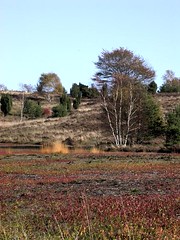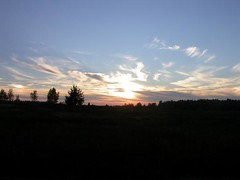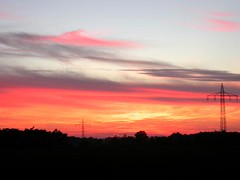 While visiting my parents last week, I played a tourist at (my old) home and went to see the Lüneburger Heide, a landscape in Northern Germany. Although I spent the first 19 years of my life there before moving away to attend University, I’ve only been to the Heide a few times. By the way, Heide means heath, and Lüneburg is a picturesque town near Hamburg.
While visiting my parents last week, I played a tourist at (my old) home and went to see the Lüneburger Heide, a landscape in Northern Germany. Although I spent the first 19 years of my life there before moving away to attend University, I’ve only been to the Heide a few times. By the way, Heide means heath, and Lüneburg is a picturesque town near Hamburg.
I took a few photos, the best of which you can see here (with commentary), or click on the image to go to the slideshow.
Sandra and Garret, remember that we talked about the Lüneburger Heide when we visited with you? Take a look at the pictures and imagine the heath blooming in purple (and white) in summer… quite a sight!
Late in the afternoon a weather phenomenon was visible that is not rare, but often overlooked: sun dogs, or parhelion (auf deutsch heißen sie Nebensonnen) are bright spots to the left and right of the sun. You can see both of them in the photo on the left; click on the photo to get a larger version. (The right sun dog is barely visible.)
Und der Sonnenuntergang rechts (klick für die große Version) ist natürlich extra für Jörg. ;-)



Hope you had fun in our backyard :-). We live just 12 km from Undeloh, and you probably drove (or biked) just a few km from our house.
We haven’t been to Wilseder Berg in ages though. I think last time we were still pushing Christopher in stroller.
Hi Scott, my parents live only about 40 km from Bispingen, but I had never been there before! I’ve only been to the Lüneburger Heide once during the Heideblüte, but I liked the area at this time of year with colourful trees and the yellow grass.
We might even have driven right past your house because we drove through a few villages, including Lüllau and Wörme (where my cousin lives) on the way home.
Oh, we do remember! It looks like glacial terrain.
For us New Mexicans, it looks like Lüneburger Heide hires gardeners. Those pines! We forget that plants can grow without constant watering … !
Garret, you’re right, the Lüneburger Heide was formed by the last ice age. It used to be a forested area, but the trees were cut because Lüneburg needed the wood for their salt refineries. Thus the heath took over and local farmers let their sheep (“Heidschnucken”, moorland sheep) graze there, which prevented trees from growing again.